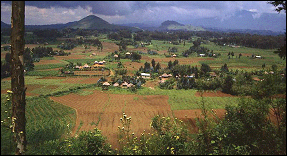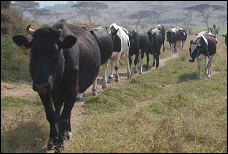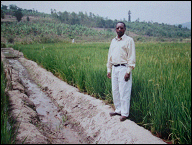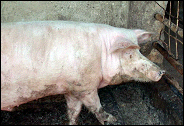 PRESENTATION
OF THE SECTOR PRESENTATION
OF THE SECTOR |
Rwandan agriculture supports 90% of the population
and contributes 40% to GDP. The country derives
practically all its foreign exchange from exports
of cash crops.

Rwanda receives bi-modal rainfall resulting in
two cropping seasons annually. In some areas,
farmers also manage to produce a third crop during
the longer dry season. The rainfall is generally
plentiful, particularly in the upland areas of
the west of the country, but sometimes drought
occurs in the south and east.
The rural landscape is characterized by intense
competition between arable agriculture, livestock
production and forestry. Rwanda is the most densely
populated country in Africa, with 8 million inhabitants
on about 1 million hectares of arable land. Subsistence
farming dominates.
The average farm size is 0.7 hectare, or 0.2 ha
per rural inhabitant. Much of this land is on
steep hillsides. The population is projected to
double by 2015 and average farm size to fall below
0.5 ha. Without any outside guidance, such pressures
will lead to further fragmentation of farms into
even small production units, with increasing loss
of economies of scale. Cropping twice a year on
steep slopes without the use of chemical fertiliser
has led to a dramatic decline in soil fertility
and to heavy soil erosion.
The war of the early 1990s and the genocide of
1994 did not spare agriculture. Rural infrastructure
was destroyed, livestock decimated, and forests
ravaged.
Until recently, government policy promoted self-sufficiency,
fostering continuing rural poverty. However, since
the late 1990s, government has recognised that,
without incentives to the contrary, the negative
trends towards ever smaller, increasingly unproductive
fields will accelerate in the future.
In this light, the government has adopted a bold
new outlook on agriculture. Its Vision 2020 policy
document identifies the agricultural sector as
one of the pillars of our development. Rwanda
will build a market-oriented agriculture, with
emphasis on intensification and commercialisation.

Intensification is dictated by the shortage of
Rwanda's farmland. Modern methods of agricultural
production increasingly allow farmers and herdowners
to take advantage of genetic enhancement of crop
and livestock species and to improve the quality
of the soils, animal feeds and farm management.
The government encourages farmers to specialise
in their mix of crops and livestock according
to market opportunities and their comparative
advantage. They should produce for the market.
Higher incomes from market-oriented production
will not only increase the welfare of many farmers.
These farmers largely spend their revenues locally,
supporting a range of non-farm rural enterprises,
thus generating employment and alleviating poverty.
The multiplier effect of non-farm employment can
exceed the direct effect of higher farm incomes
in reducing poverty but cannot take place without
improvements in agricultural technology that better
target market demand.
To achieve those goals, Rwanda has secured a 14-year
loan of US$ 165 million from the World Bank (IDA)
to support agricultural transformation in the
rural sector through a Rural Sector Support Project.
Other small loans for livestock and forestry complement
this major project.
The Ministry of Agriculture, Animal Resources
and Forestry (MINAGRI) has the mandate to:
· Develop, initiate and manage programmes
geared to the transformation and modernisation
of Rwandan agriculture
· Develop and promote improved systems
for marketing farm produce, including conservation
and processing
· Develop and promote animal production,
including large and small stock and fisheries
· Promote rational use of ecological resources
by integrating forest management into the national
economy.

|
To do so, MINAGRI has
taken several strategic decisions:
· Priority food crops A few crops were
chosen by MINAGRI for large diffusion mainly because
of their adaptability in most of the regions,
efficient use of land, high responsiveness to
fertilizers and mechanization, high nutritional
value, easy conservation and marketability. These
are maize,rice, soya, and beans.
· Cash and export crops Privatisation has
come to both the tea and coffee sectors, long-time
government monopolies. Two tea factories are
complement those of tea and coffee. MINAGRI
is also examining the potential of non-traditional
cash crops such as flowers, passion fruit and
gooseberries.
· Improved technology The government has
taken several steps to improve the productivity
of agriculture:
o Agriculture research is conducted by the
Institut des Sciences Agronomiques du Rwanda
(ISAR). Rwanda has secured a US$ 1.6 million
loan from the World Bank for the restructuring
of ISAR to make it better able to meet the
challenges of market-oriented agriculture.
o Seed improvement The National Seed
Service produces most improved seeds used
in the country. New legislation allowing NSS
control on all seeds produced or imported is
currently being ratified.
o Improved livestock The National
Insemination Centre helps the government
achieve its policy of improving the genetic profile
of local cattle. The centre plans 200,000
inseminations over the next 5 years.
o Increased use of farming inputs Government
has taken various initiatives to stimulate the
use
of chemical fertilisers. In 1999, a ministerial
decree banned the free distribution of fertilisers
; and imports of fertilisers have been duty free
since April 2000. Associations of input
distributors receive organisational training and
their members can get preferential conditions
on loans. Over a thousand demonstration plots
showing farmers the advantages of chemical
fertilisers have been organised in 8 provinces
in 2002.
o Post-harvest handling A national crop storage
programme was introduced in 2002. MINAGRI
will introduce hermetic storage equipment from
Israel.
· Rehabilitation of rural infrastructure
o Rehabilitated marshlands Rwanda is developing
a masterplan for the use of its marshlands. About
20,000 hectares should be rehabilitated in the
next 15 years, of which 4,000 exclusively for
rice. Feeder roads Access roads to high-production
zones have been rehabilitated, mostly in the 8,000
ha of pasture in Gishwati Forest and in various
rice perimeters.
o Dairy industry Milk collection centres are being
built across the country.

· Construction of rural markets
o Agricultural commodity markets In 2000 and
2001, 16 rural markets have been completed.
More will be built in the future, particularly
to serve the newly productive rehabilitated marshlands.
o Livestock markets In addition, MINAGRI is
overseeing the construction of several livestock
markets.
· Facilitation of access to credit Government
has
organised credit to dynamise agricultural production
and the marketing and processing of commodities
from the agricultural, livestock and forestry
sectors.
o The Rural Sector Support Project has a Rural
Investment Facility of US$ 8,7 million destined
to finance productive private-sector rural investments,
as well as a partnership with commercial banks,
particularly the Banque Rwandaise de Développement
with which it has arranged a 40% subsidy on certain
credit reimbursements.
o The ministry's Agricultural and Rural Market
Development Project manages a line of credit
for fertiliser imports of US$ 2 million and another
of US$ 300,000 for the purchase of agricultural
inputs. It also has a crop-insurance guarantee
bfund of US$ 400,000.
o The Dairy Cattle Development Support Project
has a fund of 300 million Rwandan francs, to guarantee
50% of the financing for the construction of small
animal-feed factories, dairy farms, processing
and marketing firms, and cattle-fattening operations.
The project also has a credit line of 500 million
Rwandan francs.
o The Rwandan Forest Management Support
Project has a line of credit of 500 million
Rwandan francs for the promotion of private-sector
operators in the sector.
Rwandan Agriculture Fact Sheet
Output of priority food crops

Production of industrial crops
Table
Livestock numbers
Table
Animal production (1,000 tonnes)
Table
Artificial insemination
Table
Reforestation
Table
|

